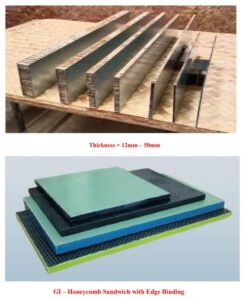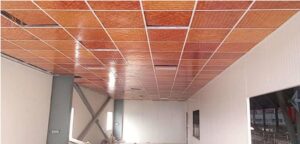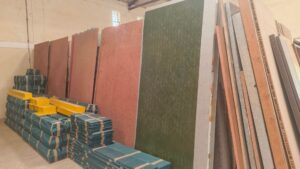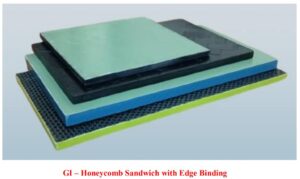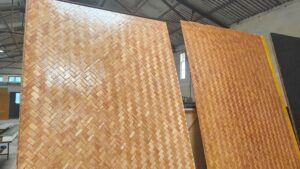As sustainable architecture advances, the demand for high-performance materials that deliver both structural strength and ecological credibility continues to grow. Among the most promising innovations in this realm are Bamboo–Honeycomb–Bamboo Sandwich Panels, available in the 10–50 mm thickness range. These panels combine a renewable bamboo skin, a lightweight honeycomb core, and advanced resin bonding techniques to offer a viable next-generation structural panel for green buildings.
What Are Bamboo–Honeycomb–Bamboo Sandwich Panels?
These panels are composed of two outer skins made of resin-impregnated bamboo woven mats, bonded on either side of a honeycomb core (typically a high-density phenol-treated core). The technology uses aerospace-derived hot-press processes to ensure uniform bonding, high stiffness, and consistent performance characteristics. According to specification documentation, this panel type is labelled “Bamboo Honeycomb Sandwich Panel – Thickness = 12.5 mm to 50 mm” and lists weight, density and strength metrics across thicknesses.
Further details from the specification table include:
For 12.5 mm thickness: weight ~0.54 kg/ft², volume density ~371 kg/m³, ~95 % weight reduction compared to steel.
For 18.5 mm thickness: volume density ~267 kg/m³.
For 25.5 mm thickness: ~213 kg/m³.
For 40 mm and 53.5 mm thicknesses: densities ~205 kg/m³ and ~171 kg/m³ respectively.
This demonstrates how the sandwich structure achieves impressive stiffness and strength with very low density, thanks to the honeycomb core.
Key Properties & Performance Benefits
High strength-to-weight ratio: The honeycomb core allows the panel to resist bending and shear with minimal material mass—ideal for large area panels or structural cladding. The specification table shows up to ~97 % weight reduction versus steel for certain thicknesses.
Lightweight construction: Densities as low as ~171 kg/m³ for ~50 mm thickness indicate very light panels compared to traditional timber or metal equivalents.
Reduced dead load: For building design this translates into lighter supporting structure, fewer framing demands, and lower transportation/handling load.
Rigidity and flatness: With the correct core-skin bonding, sandwich panels deliver superior flatness and stability – suitable for wall, ceiling, or façade panels where surface quality matters.
Thermal, acoustic insulation and durability: The panel spec lists “moisture resistant, non-corrosive, termite proof, thermal/electrical/acoustic insulation, impact resistant.”
Sustainable raw material: The use of bamboo skins—an annually renewable material—alongside engineered core technologies aligns with green building goals.
Versatility of thickness: With range from ~10 mm to 50 mm, the panels can be used for lightweight cladding through to more substantial structural infill paneling.
Applications in Green Buildings and Interiors
Wall and ceiling systems: For internal partitions, feature walls or suspended ceilings, the sandwich panel offers flat, high-quality surface with good performance.
Façade and external panels: Where aesthetic, performance and low weight matter, the panels can be used for curtain wall panels, rainscreens or external cladding systems.
Furniture and built-in joinery: The thicker variants (20–50 mm) are well-suited for built-in cabinetry, partition walls with acoustic or insulation needs, or modular furniture units.
Modular construction and prefab units: Because of their lightweight yet stiff nature, these panels lend themselves to prefabricated modules or movable building systems.
Sustainable building programmes: In any project targeting certification (LEED, GreenStar, etc), materials such as this offer credible renewable fiber content, reduced embodied weight and improved transport/handling benefits.
Advantages
Excellent combination of structural performance and lightweight build-up.
Renewable and low-embodied-energy skins thanks to bamboo.
Low density and high stiffness make it efficient for large panels.
Built-in insulation (thermal/acoustic) reduces need for secondary insulation layers.
Reduced framing and substrate weight load help cost and design flexibility.
Good durability characteristics versus pests, moisture, fungus.
Suitable for both interior and exterior applications depending on finish.
Limitations & Considerations
Cost: Hybrid sandwich panels with high-quality core/skins and aerospace-derived bonding may cost more than standard plywood or simple timber panels.
Thickness selection: For optimal performance one must select correct thickness for load-bearing or span conditions; thinner panels may not suit heavy structural infill.
Finish and edge detailing: Because they are engineered systems, edge sealing, panel joint detailing and proper substrate/fastener design are critical for performance.
Availability and lead time: Specialized material may require import or advanced manufacturing lead time in some regions.
Recycling/end-of-life: While skins are bamboo, the core and resin bonding may limit recycling compared to simple wood panels; designers should consider lifecycle strategy.
Installation expertise: While panelization simplifies construction, correct trade-installation (fixing method, substrate, tolerances) remains essential to ensure full performance benefits.
FAQs
Q1: What thicknesses are available for these sandwich panels?
They range typically from around 12.5 mm up to approximately 50 mm as per the specification table.
Q2: How much lighter are they compared to steel or conventional panels?
For example, a 12.5 mm thick panel has a density ~371 kg/m³ and ~95 % weight reduction compared to steel.
Q3: Are they suitable for exterior cladding?
Yes. The product specification notes suitability for bulkheads, boat/ship, railways etc, implying exterior or heavy-duty use.
Q4: What core material is used in the honeycomb structure?
The document describes a phenol-treated high density (>70 kg/m³) honeycomb core bonded with bamboo skins.
Q5: Can the panels be cut or worked like timber panels?
While not elaborated for this specific panel, the underlying technology references high-performance bonding and hot-pressing; standard panel work practices may apply but tool choice should consider composite nature.
Q6: Are these panels sustainable?
Yes. Use of bamboo renewable skins, lightweight cores (reducing material mass) and efficient manufacturing all support sustainability goals.
Q7: What kinds of finishes can they accept?
Given outer skins are bamboo woven mats, they can typically accept paint, polish, laminates or veneer finishes depending on project design.
Conclusion
Bamboo–Honeycomb–Bamboo Sandwich Panels (10–50 mm) embody the future of sustainable panel technology for green buildings—offering advanced performance, lightweight construction, eco-credibility and design flexibility. For architects, specifiers and builders who are looking to reduce structural load, improve thermal/acoustic properties, and align with high sustainability standards, these panels present a compelling alternative to traditional wood, metal or composite panels.
When specifying this panel type, ensure that thickness matches structural requirements, detailing is precise, finish strategy is clear and installation methodology accounts for the composite nature of the material. With the right approach, these panels offer a premium solution that blends durability, design and environmental responsibility.

